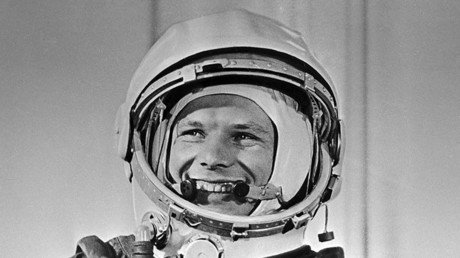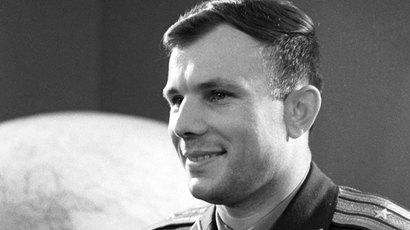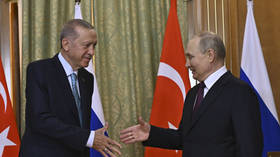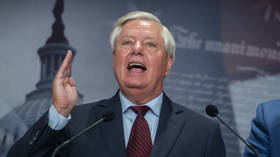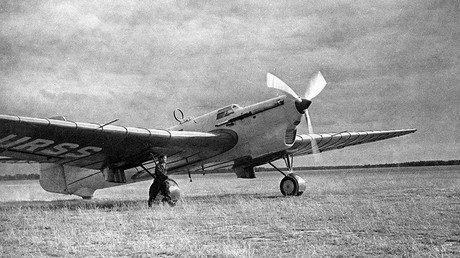Yuri Gagarin and the dream that died
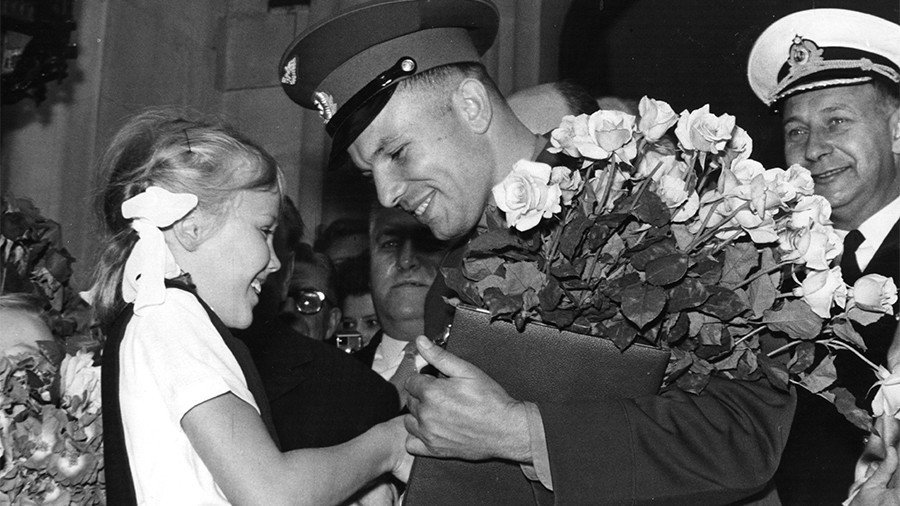
Fifty years ago today, legendary Soviet cosmonaut Yuri Gagarin tragically lost his life. Despite the unhappy ending, Gagarin’s story still inspires us, evoking memories of a positive era when man looked up towards the stars.
It’s Wednesday March 27, 1968. Yuri Gagarin, the most famous cosmonaut in the world, is working as a deputy training director at the Chkalovsky Airbase, just outside Moscow. He takes off with flight instructor and celebrated test pilot Vladimir Seryogin in a MiG-15 (MiG-15UTI) jet fighter. It’s supposed to be a routine operation, but both men are killed instantly when their plane crashes into a forest. The Soviet Union, and the whole world, mourns. Gagarin and Seryogin are buried in the walls of the Kremlin on Red Square.
If ever a story deserved a better ending it was Yuri Gagarin’s. The working-class Russian with the cheery smile was propelled to global celebrity status after becoming the first man to journey into outer space, in the spacecraft Vostok I, in April 1961. It wasn’t just Gagarin’s bravery that made him such a hit with the public, but also his sweet, boyish manner. “I am a friend, comrades, a friend,” the euphoric cosmonaut is reported to have told farm-workers after he had safely returned to Earth, in a field near Saratov in southern Russia.
Yuri Gagarin stamps from Romania, Cuba and Bulgaria pic.twitter.com/tOuTloNVBo
— 🏴 (@allgodslost) March 15, 2018
Gagarin, who had not attended university, expressed with a wonderful simplicity what he saw from space. “Orbiting Earth in the spaceship, I saw how beautiful our planet is. People, let us preserve and increase this beauty, not destroy it!” he later wrote.
His comments struck a chord with ordinary citizens around the world. He also inspired others to try and emulate him. The 1960s was an optimistic decade when people’s dreams were big. Just two months after Gagarin entered space, US President John F. Kennedy announced his nation’s ambition to land a man on the moon “before this decade is out.”
Not only was it up in space where progress was being made. The existence of a rival economic system – communism – meant that the West had to raise its game. That meant full employment, comprehensive welfare provision and a more regulated form of mixed-economy capitalism to keep voters happy. As a consequence of these progressive policies, the gap between rich and poor narrowed considerably. The Sixties was the decade that the “common man” finally got his fair share of the cake.
Significantly, the first man in space was not from an elite, establishment background, but someone whose parents had worked on a kolkhoz. Gagarin had experienced the brutal Nazi occupation of the Soviet Union, when two of his siblings were taken away and he and his family were forced to live in a tiny mud hut.
Unlike the preposterous UK Foreign Secretary Boris Johnson, and many other prominent figures in the West today, no one could say that Gagarin got to where he did because of his connections. He was just one of a number of working-class high-achievers who reached prominence in a more egalitarian and meritocratic age.
“Modest; embarrasses when his humor gets a little too racy; high degree of intellectual development evident in Yuri; fantastic memory; distinguishes himself from his colleagues by his sharp and far-ranging sense of attention to his surroundings; a well-developed imagination; quick reactions; persevering, prepares himself painstakingly for his activities and training exercises,” a Soviet air force doctor wrote of him. “No one was able to resist his smile. And girls always liked him too,” recalled Gagarin’s Botany teacher, Elena Kozlova.
Having been driven through the streets of Moscow with Soviet leader Nikita Khrushchev beside him, Gagarin embarked on a world tour. One of the counties he visited was Britain, where thousands turned out to meet him at Manchester airport. Despite the rain, he was mobbed by jubilant crowds wherever he went. Even the Queen was taken by Gagarin’s charm, and gave him some beautiful dolls to give to his daughters. “It is hard to imagine the star quality that Gagarin carried,” writes space author Francis French. “In fact, it had more in common with Beatlemania than the later, formal visits of other space-farers. This was about something that had never been achieved before in human history, and here was a chance to meet the man who did it.”
The Daily Express commented: “Would the welcome have been any greater had the cosmonaut been an American or even a Briton? I, for one, doubt it.”
The Vostok 1 success was of course not just a testament to Gagarin but to the achievements of Soviet science. Even British Conservative politicians were impressed.
“Forty years ago the Soviet Union was a backward country, poor, illiterate, agricultural. Today she is identified with prodigious feats of science and technology,” wrote Aubrey Jones in the Sunday Times (which back then was not owned by Rupert Murdoch). Today, the Times and Sunday Times are crude neocon propaganda organs pumping out Russophobic commentary. In the 1960s, they were still objective newspapers of record, which gave credit where it was due.
Gagarin was awarded the title of Hero of the Soviet Union, but he was the world’s hero too. The authorities were understandably keen to protect him and keep him away from any more space missions.
It’s worth remembering what a dangerous business being a cosmonaut was. In 1961, Valentin Bondarenko died as a result of injuries he suffered in a fire in a special low pressure training chamber. In 1967, another famous Russian spaceman, Vladimir Komarov, a close friend of Gagarin’s, died when his capsule’s parachute failed to open properly when re-entering Earth’s atmosphere.
That might have been Gagarin’s fate, but one year later he was dead, too. Questions were soon being asked as to how the two airmen had been killed in what was a routine exercise.
The commission set up by the Central Committee of the Communist Party concluded that the “most probable cause” of the crash was that either Gagarin or Seryogin had swerved sharply, probably to avoid a weather balloon, leading the plane into a “supercritical flight regime and to its stalling in complex meteorological conditions.”
Russian documents declassified in March 2003, on the 35th anniversary of Gagarin’s death, revealed that the KGB had conducted its own investigation, in which it blamed an air traffic controller for providing Gagarin with weather information which was out of date by the time of his flight.
Various theories abounded for many years, but in 2013, Alexey Leonov, the famous cosmonaut, told RT what had really happened. It seems the crash was caused by an unauthorized SU-15 fighter flying too close to Gagarin’s plane.
“In this case, the pilot didn’t follow the book, descending to an altitude of 450 meters [1,475ft]. I know this because I was there; I heard the sound and talked to witnesses. While afterburning the aircraft reduced its echelon at a distance of 10-15 meters in the clouds, passing close to Gagarin, turning his plane and thus sending it into a tailspin – a deep spiral, to be precise – at a speed of 750kph,” Leonov said.
Gagarin’s death was a shattering blow. “I still miss him. It is a loss not only for us cosmonaut community, but for the entire community,” said Valentina Tereshkova, the first woman in space, in 2013. His daughter Elena recalled her father’s love of books. “He knew Pushkin very well, and Tvardovsky and Isakovsky – poetry connected with the war. He liked a great deal of literature: Lermontov and Saint-Exupery, for example… He was curious and interested in everything."
What, I wonder, would Yuri make of the world today?
Just one day before the 50th anniversary of his death, the US expelled 60 Russian diplomats, despite no evidence being produced of Kremlin involvement in the Skripal case.
The day when over 60 people -including 40 children are killed in a shopping mall blaze in Russia is ‘Happy International expel a Russian diplomat day’. https://t.co/CxslSHHQ6Z
— Neil Clark (@NeilClark66) March 26, 2018
Meanwhile, depressive, sociopathic neocons fume over the defeat of Western-backed head-chopping ‘rebels’ in Syria and threaten war with Syria, Iran and Russia.
The summer of 1966. When British citizens could travel peacefully from London to Baghdad by train via socialist Yugoslavia and purchase sweet-smelling ripe melons at village stations in Syria. The world before destructive NeoCons took over western foreign policy. pic.twitter.com/fRhSu4rEhU
— Neil Clark (@NeilClark66) March 25, 2018
It’s not just in the sphere of international relations where we’ve gone backwards. The gap between rich and poor, which was shrinking all the time in the 1960s, has widened massively, with Oxfam reporting that in 2017, 82 percent of the wealth created globally went to the top 1 percent.
Meanwhile, environmental destruction continues apace. Have we really done what the far-sighted cosmonaut told us to do and preserved the beauty of the planet?
While there have obviously been great technological and medical advances, no one can truthfully say that mankind generally is in a better place than in the Sixties.
Shed a tear today not just for Yuri Gagarin, the modest, cheerful and open-hearted first man in space.
But also for the world we have lost.
Follow Neil Clark on Twitter @NeilClark66
The statements, views and opinions expressed in this column are solely those of the author and do not necessarily represent those of RT.

